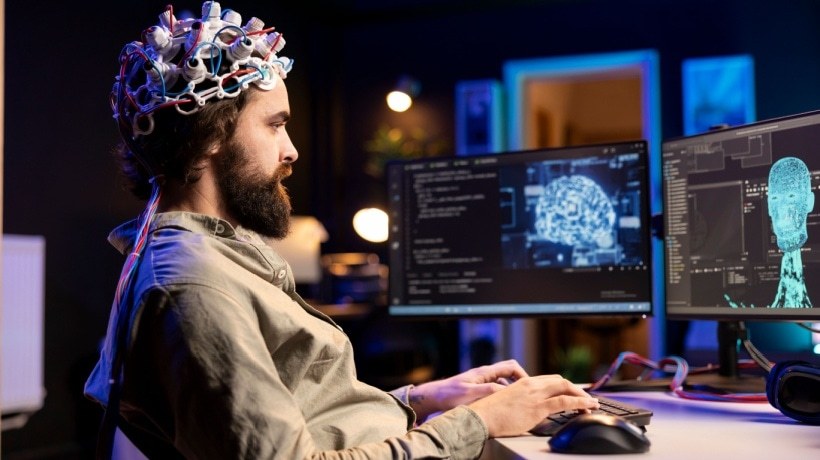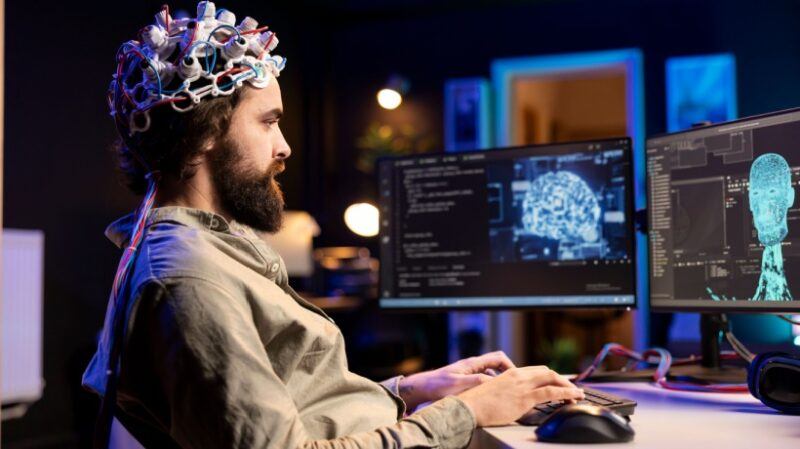
Neuroadaptive Learning And Brain-Computer Interfaces

Understanding Neuroadaptive Learning
Not long ago, the idea of computers understanding how students feel or think sounded like science fiction, but today, it is becoming a reality. This is called neuroadaptive learning, and it’s basically a combination of education, neuroscience, and AI. This approach allows learning systems to adapt in real time based on what’s happening in a student’s brain, creating a personalized and responsive experience. For example, a classroom that can sense when you’re losing focus or feeling overwhelmed and instantly adjusts the lesson to keep you engaged can happen thanks to Brain-Computer Interfaces (BCIs). These interfaces act as a bridge between the brain and digital systems, making it possible to tailor education to each learner’s unique mental and emotional state.
So, what exactly is neuroadaptive learning? As we said, it’s the perfect blend of neuroscience, AI, and educational technology, designed to create smarter learning environments that respond to the brain’s signals. The ultimate goal of neuroadaptive learning is to make education more engaging, personalized, and effective by adjusting to how each student learns best. It’s about recognizing that every brain works differently and giving learners what they need when they need it.
Some early versions of these systems are already being tested in virtual classrooms and eLearning platforms, where they monitor engagement and fine-tune learning paths in real time. For instance, a student might have their lesson shortened when they show signs of fatigue. If this approach is more widely used, it can help teachers know exactly if what they’re teaching is effective. However, before we get started, let’s take a closer look at the idea and examine how BCIs work in neuroadaptive learning and what the benefits are.
Types Of Brain-Computer Interfaces
Non-Invasive
Non-invasive BCIs are the most common type and the most practical for everyday use, especially in educational settings. This is because they don’t require surgery or direct contact with the brain. Instead, they rely on external sensors placed on the scalp to detect brainwave patterns. The most popular form of non-invasive BCI is electroencephalography, or EEG for short. EEG-based devices measure electrical signals generated by neurons in the brain. These signals are extremely subtle, but with the help of sensitive electrodes, they can be recorded and analyzed to reveal patterns related to attention, engagement, stress, or fatigue. EEG headbands are wearable devices that look like headphones. They can read the user’s cognitive state in real time, so even if a student loses their attention or they begin feeling mentally overloaded, the system could detect those signals and adjust the lesson accordingly. This makes learning a truly personalized experience.
Invasive
On the other hand, we have invasive BCIs. It’s a far more complex and high-risk category that involves surgical implantation of electrodes directly into the brain tissue. These devices offer a much clearer and more precise picture of brain activity since they record signals directly from the neurons.
Because of their accuracy, invasive BCIs are mostly used for medical and research purposes, not education. They have helped people with severe physical disabilities or neurological conditions regain lost abilities, as some invasive BCIs allow people with paralysis to control robotic limbs, type on a computer, or even communicate through their thoughts. In these cases, the electrodes are implanted in specific brain regions responsible for movement or communication, and the signals are sent to external devices that execute the intended action. While the potential of this technology is great, it also comes with serious challenges. Brain surgery is invasive. This increases the risks of infection, inflammation, and long-term health implications. That’s why such systems are strictly used for medical and experimental reasons.
Where Are BCIs Used?
Cognitive Training Games
BCIs have already started to find their way into classrooms. While the technology is still new, the ways it’s being tested and used show that it could reshape learning in the future. One of the most exciting applications of BCIs is in cognitive training games. These games are designed to strengthen skills like memory, focus, and problem solving, and with the help of BCIs, can now respond to your brain activity in real time. For example, while playing such a game, your character speeds up when you’re fully focused and slows down when your attention starts to drift.
Integration With AR/VR
BCIs can also integrate with AR and VR. While wearing a VR headset and exploring the solar system, a BCI can track the user’s engagement and emotional state. If it senses that their attention is fading, the system might slow down, offer hints, or add more interactive elements to engage them again. The combination of BCIs with Virtual and Augmented Reality creates truly immersive, adaptive learning experiences. These tools are being tested in fields like medical training and engineering, where students can practice complex tasks in safe, simulated environments while receiving feedback that aligns with their cognitive performance.
Special Education
BCIs are also making a meaningful difference in special education. For students with physical or neurological challenges, these interfaces can offer opportunities that traditional tools simply can’t. For instance, children with limited mobility can use BCIs to interact with digital lessons, play educational games, or communicate without needing a keyboard or mouse. Some schools are experimenting with simple EEG-based devices that help teachers understand when students are feeling overwhelmed or disengaged, allowing them to adjust the lesson pace in real time.
STEM Training
In STEM education, pilot programs are using BCIs to support hands-on learning in science and math. Students can receive neurofeedback while solving problems, helping them identify when they feel stressed or distracted and learn how to regain focus more effectively.
Adaptive Testing
Beyond classrooms, BCIs have contributed to new methods of assessment, too. Adaptive testing, for example, uses brain signals to determine when a student is struggling or finding questions too easy and then adjusts the difficulty to match their ability level.
Emotional Regulation
Emotional regulation is another area where BCIs have proven useful. In neuroadaptive learning, these systems can detect when students are anxious or frustrated and guide them through breathing or mindfulness exercises to calm them before continuing.
Neurofeedback Learning
Finally, neurofeedback learning, where students see real-time visualizations of their brain activity, helps them understand how their minds respond to stress and focus. Over time, this knowledge can help them be more motivated and perform better.
Benefits Of Neuroadaptive Learning And BCIs
Personalized Learning
When learning something new, like a language, a math concept, or even a new app, some things are easily understandable, while others are not. Traditional learning systems don’t address this, but neuroadaptive learning does. By connecting to brain-monitoring tools, like EEG headbands that read electrical activity in the brain, the system can detect how focused or mentally tired a student is and adapt accordingly. If someone loses focus, the system can then slow down, simplify the content, or make the content more engaging. If a student is finding the topic easy, the system can increase the challenge level.
Enhanced Engagement
Staying focused for long when learning, especially with so many distractions around, is tough. Neuroadaptive systems help with that, as they sense engagement. When they realize users lose interest, the systems can react by offering interactive quizzes, short videos, or even a mental break suggestion. This creates a more responsive learning experience that keeps students active rather than bored.
Cognitive Insights
Neuroadaptive learning helps both students and teachers understand how learning happens on a cognitive level. Instead of guessing whether a student is struggling, tired, or stressed, educators can see patterns in real time. For example, BCIs can detect changes in brain activity that relate to stress or mental overload. If a student is showing signs of fatigue, the system might recommend a short pause or an easier task. Teachers could use this information to design better lessons that match students’ pace. Over time, this data helps build a detailed profile of each learner’s cognitive behavior. This, in turn, helps teachers understand when and how each person learns best.
Accessibility
Neuroadaptive learning and BCIs can make education more accessible for people with disabilities. For learners who face physical challenges, communication barriers, or neurological conditions, traditional methods can be limiting. But BCIs can help. Let’s talk about students who are unable to use a keyboard or speak due to mobility impairments. They can use a non-invasive BCI and control a computer or navigate digital lessons using only their thoughts. BCIs can also support students with learning differences like ADHD, dyslexia, or autism. By recognizing when attention drops or stress rises, neuroadaptive systems can tailor the environment to keep the learner comfortable and focused.
Improved Outcomes
Ultimately, all these benefits come together to improve learning outcomes. When content adapts to the learner’s brain activity, students are more engaged, less confused, and understand the learning content better, according to studies. After all, when students aren’t distracted, tired, or uninterested, their brains are free to focus entirely on information. Therefore, learning becomes more rewarding, which can change how students view education.
Conclusion
The exciting part about neuroadaptive learning isn’t just how technology has advanced, but also the fact that we can understand how humans actually learn. However, while neuroadaptive learning gives us amazing possibilities, it also raises important questions about privacy, ethics, and data security. How do we protect something as personal as brain data? That’s where stakeholders must collaborate to create ethical and inclusive policies that keep learners safe.
Source link



